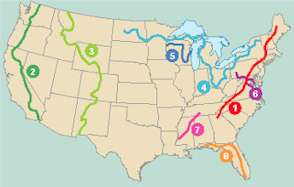A selection of mountains that we tend to climb and ski every year. We never get tired of these.
A person who climbs several times a year, is usually seen on the more popular routes and often strives towards climbing Mount Rainier.
A crack in the snow at the beginning or end of a steep slope. Resembles a crevasse except that they usually go all the way to the ground.
A path in the snow that you beat down with your boots. It resembles a staircase and becomes easier to ascend with each pass. Useful when the slope is too steep to skin or when you plan on skiing down a number of times.
Snow that resembles corn. Grain size and depth can vary. Forms through a series of freeze/thaw cycles. Great stuff to ski.
A wind drift that resembles a cresting wave. Usually forms on the leeward side of ridges during the winter. Great for jumping.
A fee charged for attempting to climb a mountain. Often included in a climbing permit. Somewhere in the neighborhood of $15, the money is supposed to go towards maintenance and other costs in dealing with climbers. I also think it helps limit usage.
Something you fill out when attempting to climb a mountain. Helps keep track of and control usage.
The first time that a route is descended using a particular style -- skiing, snowboarding etc.
Troy's forth car. His biggest -- F250 7.3 liter Diesel. We usually end up taking it because it's comfortable, seats four, and can go just about anywhere. He claims to need it for work but I think it has something to do with his image.
The Ford at home in the mountains. Packing up after a ski trip just before dark at the Nirada Falls parking lot, Mount Rainier.
Mountains that are between 14,000 and 15,000ft high. There are quite a few of these in Colorado, California and one in Washington.
My first car. A 1984 Mazda B2000 that I've had since high school. It has taken me many places without much trouble. The canopy is nice because I can sleep in back.
The Mazda at home near Shilshole Marina, Seattle.
A small rockwall in Yakima that I trained, worked and socialized at. It was located in a small corner of Gymnastics Plus. The owner was Norm Reid, an excellent climber, who taught me a lot about the sport among other things. I rode my bike there nearly every evening, 8th grade through high school, and worked there during the later half to help build and maintain it. I'll never forget the people I met and times we shared there.
Climbing to the top and back from the car in less than 24 hours.
A National Scenic Trail extending from Mexico to Canada. The trail passes trough three states (California, Oregon and Washington) spanning 2,650 miles. The PCT is one of the first scenic trails in the National Trails System authorized by Congress in 1968, and was dedicated in 1993. (see Figure 1)

Figure 1:
National Scenic Trails: (1) Appalachian Trail (2) Pacific Crest Trail (3) Continental Divide Trail (4) North Country Trail (5) Ice Age Trail (6) Potomac Heritage Trail (7) Natchez Trace Trail (8) Florida Trail
Recreational Equipment Inc. A popular outdoor gear retailer. Their new store in downtown Seattle has become a tourist destination. Too many people with too little interest. Not a good place to be on the weekends.
Possible to descend on skis. There really is no such word.
A device that covers the base of your ski that allows you to ski uphill. They are smooth in one direction and rough in the other.
The easy route up the south side of Mount Adams. The route involves a short approach (2 miles) and a short climb (4000 vertical feet) up a 30 degree snowfieild. Altitude and weather are the main challenges. My challenge is dealing with the crowds.
The Hummel's second car. It's not the most comfortable ride but it gets them where they're going.
The gear in each of those packs costs more than the Sport Truck itself.
Paper sign-in on top of a mountain. They are usually enclosed in some type of heavy canister or box with a writing device.
Formations in the ice or snow that begin as small bowls where the snowmelt is non-uniform. They may end up as large bowls or even spikes. They tend to form in late summer and early fall and make for very difficult skiing.
When a kayaker flips and has to pull his or her sprayskirt to get out of their boat. Swimming can be painful and loosing gear is likely. Rolling is the preferred alternative.